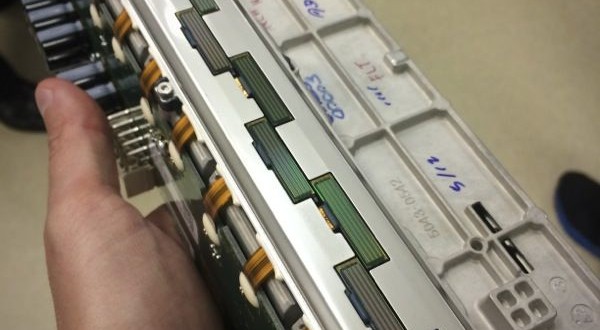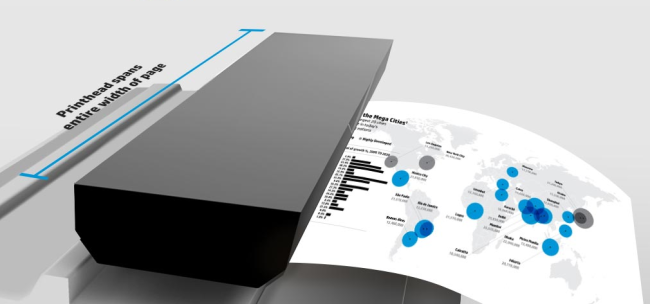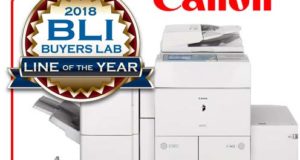When most people think of inkjet printers they recall the standard moving print head systems that go back and forth across the page. We were able to get a more in depth look at the tech behind this new development at a recent press event at HP’s Corvallis campus. When HP introduced its PageWide technology they unveiled a print bar that spanned the entire width of the printed page. This product first appeared in their Officejet Pro X series inkjet printers (including the HP Officejet Pro X476dn MFP and the HP Officejet Pro X576dw MFP). It’s now also part of their Officejet Enterprise X Series color MFPs. Roger Clojay, who manages the team that developed the page wide print bar, gave us a closer look at this technology and explained a little bit about how it works and how the technology emerged from more traditional methods of inkjet printing. First and foremost, HP had to figure out how to ramp up the speed of these printers. Speeding up the print head and timing it with the advancement of the page had been all but maxed out in terms of its potential. A new way of getting ink to the page was needed. The OfficeJet Pro X series MFPs use a full color page wide print bar that is fixed in place. The paper goes past the bar instead of the other way around.
HP PageWide Technology – a Faster Way to Print Ink
The HP PageWide print bar actually senses when it needs more ink from the four CMYK supply cartridges. This is because 10 dye carrier assemblies are part of the print head unit. It was really cool to see the methods HP uses to examine the individual component parts, including medical-grade scanning that lets HP’s engineers literally dissect and evaluate the print bar. It’s this process that helped them refine and develop the idea into a full functioning model for color inkjet printing.
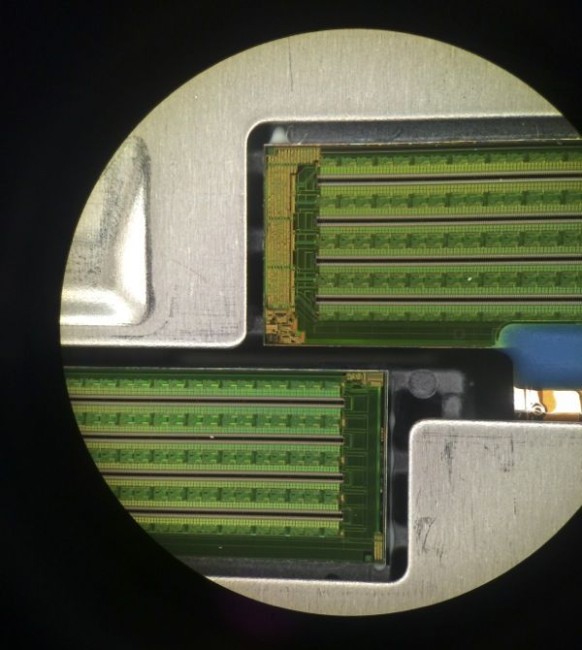
I literally captured this photo by placing my camera up against a magnifying glass that was looking at an HP PageWide print head
Thinking From Big to Small
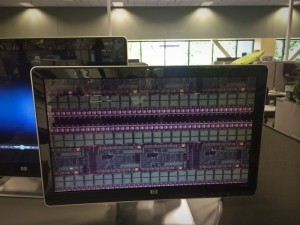 In thinking through how to manipulate ink and get it to the page, HP PageWide technology had to be built understanding how to take and deliver ink from the macro scale (the ink supply) to the micro scale. The source ink gets funneled down until it gets to the firing chambers (there are 4000 nozzles per dye). It gets down to around a ~15 micron diameter print head. (That’s roughly the size of a red blood cell!) As the HP PageWide technology moves from system to system, and as the company increases their capabilities, they have to upgrade the very tools and equipment needed to produce and fabricate the parts. Everything is necessarily fabricated in clean rooms in order to insure particulates are kept out of the process. HP is clearly pushing the industry in the area of inkjet, and everything we saw was made by them as opposed to simply gathered from industry-existing components and processes. What’s next for PageWide? Well, HP wouldn’t let the cat out of the bag, but we’d imagine the technology could make its way further and further “down the food chain”
In thinking through how to manipulate ink and get it to the page, HP PageWide technology had to be built understanding how to take and deliver ink from the macro scale (the ink supply) to the micro scale. The source ink gets funneled down until it gets to the firing chambers (there are 4000 nozzles per dye). It gets down to around a ~15 micron diameter print head. (That’s roughly the size of a red blood cell!) As the HP PageWide technology moves from system to system, and as the company increases their capabilities, they have to upgrade the very tools and equipment needed to produce and fabricate the parts. Everything is necessarily fabricated in clean rooms in order to insure particulates are kept out of the process. HP is clearly pushing the industry in the area of inkjet, and everything we saw was made by them as opposed to simply gathered from industry-existing components and processes. What’s next for PageWide? Well, HP wouldn’t let the cat out of the bag, but we’d imagine the technology could make its way further and further “down the food chain”
The Case for Inkjet in a Toner World
Andy Binder, General Manager, Enterprise Ink, Printing and Personal Systems for HP had some interesting things to say regarding using inkjet technology for enterprise printing. Since customers are so driven by low cost of ownership, reliability, and low hassle performance, the color enterprise MFP segment directly targets general office printing. It hits the market with low transactional costs—low acquisition cost, low cost-per-page, and fast speed. It also has a low contractual cost—a low delivery cost and lower cost to deploy multiple units in an office or workgroup environment. The HP Officejet Enterprise X series is an A4 product that delivers a very low cost per page alternative to centralized A3 copiers.
As mentioned above, what makes HP’s PageWide array so compelling is that the company has created the world’s fastest desktop MFP and they did it with less moving parts than any other inkjet or toner-based product. Since the 8.5″ print head never actually touches the paper, the system is extremely durable and long-lasting. At 70 ppm print speeds and with the lowest cost per page, the PageWide enterprise technology seems like a great start to a technology that seems destined to shake up the industry. Currently, the ink used in these new HP Officejet Enterprise X printers have yields that are close to 10,000 pages black and 6,600 color. These new inks are pigment based so they provide more permanency and highlighter and water resistance.
Conclusion
So far, HP has printed over 60 billion pages with this new PageWide technology (the first printer using this new head was released back in 2006). They are now on their fifth generation product and they seem to be moving successfully forward with the goal of printing at twice the speed, at half the cost. For reference, the HP OfficeJet Enterprise X585 MFP can serve between 5 and 15 users and can print at a cost of just $0.011 per page in mono. The thing about HP PageWide technology is that they seem to be making a lot of good calls so early into the process. For example, HP is working to provide moreways for offices to save money. Using the GO (General Office) mode you can save an additional 20% of ink and get your cost per print down to $0.008 per page possible. For service tracking, it has a helpful feature for companies using a little color in their logos. If the color in your logo is than 0.5″ x 0.5″ the page is treated as mono. And finally, with no fuser, the Officejet Enterprise X series MFPs use up to 90 percent less energy than comparable toner-based products. About the only consumable part besides ink is the ink collection unit—and that is designed to last for 110,000 copies and be replaced by the user.
We’ve got the HP Officejet X585 in for review right now and have been very impressed with its initial performance. More information will follow, but if this is any indication of what’s yet to come, HP is going to present some compelling options in the print marketplace.
 CopierGuide Copier and Multifunction Printer Leases and Reviews
CopierGuide Copier and Multifunction Printer Leases and Reviews

